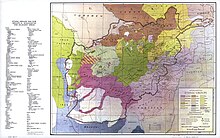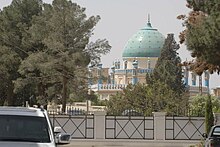Pashtuns
[50][51][52] In India, significant and historical communities of the Pashtun diaspora exist in the northern region of Rohilkhand, as well as in major Indian cities such as Delhi and Mumbai.[28] Big cities with a Pashtun majority include Jalalabad, Kandahar, Bannu, Dera Ismail Khan, Khost, Kohat, Lashkar Gah, Mardan, Ghazni, Mingora, Peshawar, Quetta, among others.[citation needed] The city of Karachi, the financial capital of Pakistan, is home to the world's largest urban community of Pashtuns, larger than those of Kabul and Peshawar.In order to secure Durrani control in southern Afghanistan, Nader Shah deported Hussain Hotak and large numbers of the Ghilji Pashtuns to the Mazandaran province in northern Iran.Yet to the Trtsus came the Ārya's Comrade, through love of spoil and heroes' war, to lead them.Heinrich Zimmer connects them with a tribe mentioned by Herodotus (Pactyans) in 430 BCE in the Histories:[88][89][90] Other Indians dwell near the town of Caspatyrus[Κασπατύρῳ] and the Pactyic [Πακτυϊκῇ] country, north of the rest of India; these live like the Bactrians; they are of all Indians the most warlike, and it is they who are sent for the gold; for in these parts all is desolate because of the sand.These Pactyans lived on the eastern frontier of the Achaemenid Arachosia Satrapy as early as the 1st millennium BCE, present-day Afghanistan.[92] Thomas Holdich has linked them with the Afridi tribe:[93][94][95] The Sattagydae, Gandarii, Dadicae, and Aparytae (Ἀπαρύται) paid together a hundred and seventy talents; this was the seventh provinceJoseph Marquart made the connection of the Pashtuns with names such as the Parsiētai (Παρσιῆται), Parsioi (Πάρσιοι) that were cited by Ptolemy 150 CE:[96][97]"The northern regions of the country are inhabited by the Bolitai, the western regions by the Aristophyloi below whom live the Parsioi (Πάρσιοι).The best known tribes are those who deprived the Greeks of Bactriana, the Asii, Pasiani, Tochari, and Sacarauli, who came from the country on the other side of the Iaxartes (Syr Darya)"This is considered a different rendering of Ptolemy's Parsioi (Πάρσιοι).[124][126] Al-Utbi, the Ghaznavid chronicler, in his Tarikh-i Yamini recorded that many Afghans and Khiljis (possibly the modern Ghilji) enlisted in the army of Sabuktigin after Jayapala was defeated.I have read in the Mutla-ul-Anwar, a work written by a respectable author, and which I procured at Burhanpur, a town of Khandesh in the Deccan, that the Afghans are Copts of the race of the Pharaohs; and that when the prophet Moses got the better of that infidel who was overwhelmed in the Red Sea, many of the Copts became converts to the Jewish faith; but others, stubborn and self-willed, refusing to embrace the true faith, leaving their country, came to India, and eventually settled in the Sulimany mountains, where they bore the name of Afghans.[131][132][29] Historians have also come across references to various ancient Indo-Aryan tribes called Pakthas (Pactyans) between the 2nd and the 1st millennium BC,[133][134][135] although according to Richard N. Frye the identification of Pashtuns with the Pakhtas is a mere guess and not proven.[152] Henry Walter Bellew, who wrote extensively on Afghan culture, noted that some people claim that the Bangash Pashtuns are connected to Ismail Samani.For example, according to the Encyclopaedia of Islam, the theory of Pashtun descent from Israelites is traced to Nimat Allah al-Harawi, who compiled a history for Khan-e-Jehan Lodhi in the reign of Mughal Emperor Jehangir in the 17th century.Historian André Wink suggests that the story "may contain a clue to the remarkable theory of the Jewish origin of some of the Afghan tribes which is persistently advocated in the Persian-Afghan chronicles.A claim that is full of logical inconsistencies and historical incongruities, and stands in stark contrast to the conclusive evidence of the Indo-Iranian origin of Pashtuns supported by the incontrovertible DNA sequencing that the genome analysis revealed scientifically.During the so-called "Great Game" of the 19th century, rivalry between the British and Russian empires was useful to the Pashtuns of Afghanistan in resisting foreign control and retaining a degree of autonomy (see the Siege of Malakand).However, during the reign of Abdur Rahman Khan (1880–1901), Pashtun regions were politically divided by the Durand Line – areas that would become western Pakistan fell within British India as a result of the border.[184][185] Many Pashtuns also worked in the Muslim League to fight for an independent Pakistan through non violent resistance, including Yusuf Khattak and Abdur Rab Nishtar who was a close associate of Muhammad Ali Jinnah.The Afghan monarchy ended when President Daoud Khan seized control of Afghanistan from his cousin Zahir Shah in 1973 on a Pashtun Nationalist agenda, which opened doors for a proxy war by neighbours.In the meantime, millions of Pashtuns joined the Afghan diaspora in Pakistan and Iran, and from there tens of thousands proceeded to Europe, North America, Oceania and other parts of the world.[188] Many high-ranking government officials in the Islamic Republic of Afghanistan were Pashtuns, including: Abdul Rahim Wardak, Abdul Salam Azimi, Anwar ul-Haq Ahady, Amirzai Sangin, Ghulam Farooq Wardak, Hamid Karzai, Mohammad Ishaq Aloko, Omar Zakhilwal, Sher Mohammad Karimi, Zalmay Rasoul, Yousef Pashtun.Other prominent Pashtuns include the 17th-century poets Khushal Khan Khattak and Rahman Baba, and in contemporary era Afghan Astronaut Abdul Ahad Mohmand, former U.S.[249] Robert Nichols remarks:[250] The politics of writing Pashto language textbooks in a nationalist environment promoting integration through Islam and Urdu had unique effects.[264] Most decisions in tribal life are made by members of the jirgá (Pashto: جرګه), which has been the main institution of authority that the largely egalitarian Pashtuns willingly acknowledge as a viable governing body.Many Pashtuns are prominent Ulema, Islamic scholars, such as Maulana Aazam an author of more than five hundred books including Tafasee of the Quran as Naqeeb Ut Tafaseer, Tafseer Ul Aazamain, Tafseer e Naqeebi and Noor Ut Tafaseer etc., as well as Muhammad Muhsin Khan who has helped translate the Noble Quran, Sahih Al-Bukhari and many other books to the English language.[270] Little information is available on non-Muslim as there is limited data regarding irreligious groups and minorities, especially since many of the Hindu and Sikh Pashtuns migrated from Khyber Pakhtunkhwa after the partition of India and later, after the rise of the Taliban.Due to the ongoing insurgency in Khyber Pakhtunkhwa, some Pashtun Sikhs were internally displaced from their ancestral villages to settle in cities like Peshawar and Nankana Sahib.Pashtun scholars such as Abdul Hai Habibi and others believe that the earliest Pashto work dates back to Amir Kror Suri, and they use the writings found in Pata Khazana as proof.[304] In Afghanistan, some Pashtuns still participate in the ancient sport of buzkashi in which horse riders attempt to place a goat or calf carcass in a goal circle.[310] The decades of war and the rise of the Taliban caused considerable hardship among Pashtun women, as many of their rights have been curtailed by a rigid interpretation of Islamic law."[316] Further challenging the status quo, Vida Samadzai was selected as Miss Afghanistan in 2003, a feat that was received with a mixture of support from those who back the individual rights of women and those who view such displays as anti-traditionalist and un-Islamic.

















AfghansPathan (disambiguation)PashtoPakistan2023 censusAfghanistanUnited StatesUnited KingdomTajikistanCanadaRussiaAustraliaUzbekistanWanetsiCentral PashtoSouthern PashtoNorthern PashtoSunni IslamIranian peoplesnomadicpastoraleastern Iranic ethnic groupethnic groups in AfghanistanPashto languageEastern IranianIranian language familyPashtun tribes and clansvariety of origin theoriesShahid Javed Burkilack of an official census in Afghanistan since 1979ethnic group in PakistanPashtun diasporaRohilkhandMumbaiCultureDiasporaDiscrimination against PashtunsList of PashtunsLanguageTribesEmpires and dynastiesKhalji BengalKhalji DelhiLodi DelhiKarraniTaymanisDurraniBarakzaiEthnic groups in PakistanAmu riverIndus RiverJalalabadKandaharDera Ismail KhanLashkar GahMardanGhazniMingoraPeshawarQuettaAbbottabadIslamabadKarachiKunduzLahoreMazar-i-SharifMianwaliAttockPathans in IndiaPashtuns of KashmirPathans of PunjabPathans of SindhPathans of GujaratPathans of Uttar PradeshPathans of Madhya PradeshMuslim conquest in the Indian subcontinentpartition of IndiaUniversity of LucknowBritish Rajcolonial IndiaFarrukhabadCalcuttaSaharanpurJaipurBangaloreBritish IndiaUttar PradeshRohillaRoyal House of RampurMaharashtraWest BengalBombayRajasthanKarnatakaSanjayAkbar KhanCaribbeanSouth AfricaTrinidadSurinamGuyanaassimilatednortherncentral Indiamigrated to PakistanUrdu-speaking communitieslocal societyDurrani PashtunsKhorasan provinceSafavid IranGhilji Pashtuns in IranNader ShahHussain HotakGhilji PashtunsMazandaran provinceDurrani EmpireTimur Shah DurraniMashhadAzad Khan AfghanAzerbaijanAfsharid rulesouthern part of the Iranian Khorasan provinceAfghan diasporaOverseas PakistaniCommonwealthcommonwealth countries